A Sampling
Jacks
Jacks, also called jackstones, fivestones, or dibs, is one of the oldest and most widespread games in the world. Children in ancient Egypt played a version of the game, known as “knucklebones,” with sheep toe bones. The game of knucklebones led to dice games for boys, and a version of modern jacks known as Fivestone, for girls, was played with a wooden ball. Eventually, a rubber ball replaced the wooden one and the modern version of the game as we know it was born.
Although the game of jacks is played by children around the world, in the United States it is played with six to 12 or more six-pronged iron or plastic jacks and a small ball. After the jacks are strewn on the floor, the player tosses the ball into the air and then tries with one hand to pick up the jacks and catch the ball, usually before it bounces. If the player fails in this, the turn passes to the next player. The game becomes increasingly difficult; first, one jack has to be picked up, then two at a time, next three, and, finally, all must be grasped in the hand before the ball is caught.
Vintage Jack games can be found on eBay for between $9.99 and, at the high end, around $40. Over the years, jacks have been produced using different types of materials, from metals to plastic, and in various colors. Collectors look for age of manufacture (older, metal jacks are preferred), a complete game package, and sets that still have the original rubber ball.
No one really knows when the first marble was made or when the game of marbles began, although evidence exists that many ancient civilizations played with marbles. The earliest examples were made from stones. In Roman literature, there are references that the game of marbles being played with nuts. Through the centuries, marbles have been made from ground down semi precious stones such as marble (hence, the name) and limestone, produced using clay and different ceramics techniques, and made from hand-blown glass. In the U.S., Akron, Ohio was put on the map as the marble capital of the nineteenth century with the invention of the first machine for manufacturing glass marbles.
While numerous games can be played with marbles, “The Ring Game” is the most famous version. A 3-foot wide ring is drawn on the ground either with a piece of chalk or with a stick in the dirt, along with a starting line just outside the ring. Each player puts a few marbles into the ring and the goal is to shoot the marbles, from the starting line, to knock marbles out of the ring. The winner has the highest amount of marbles knocked out of the ring compared to the other players. The skill of the game is in the “flick” of the marble.
Collecting marbles is a popular hobby, with market values dependent on type (handmade, non-glass, machine-made and art glass), color, size, manufacturer, age, and country of origin. Although marbles can be affordable for all collector budgets, avid collectors know that prices can range into the thousands of dollars for rare and interesting examples. A single antique Ribbon Lutz marble is selling for $925 online.
The game of Croquet can trace its origins back to 1852 when a game called “crooky” was introduced to England from Ireland where it had been played since the 1830s. After World War II, toy makers miniaturized the standard croquet set, simplified the rules, and marketed croquet as a backyard “children’s game.” Since then, the game of Backyard Croquet has maintained its popularity in America as both a sporting event (according to
croquetamerica.com, as many as 10,000 men and women play this elegant and exacting sport on more than 600 greens across the U.S. and Canada), and a favorite activity for children and adults at garden parties, family gatherings, picnics, and social events.
A basic croquet set consists of 6 hoops, 1 peg, 4 mallets, and 4 balls colored red, black, yellow, and blue. While croquet is a game played around the world, the United States has its own set of rules for domestic games, which can be played with two, four, or six players. The game involves hitting your own colored ball through a circuit marked with two stakes and nine metal wickets. After striking the ball with the mallet through the first set of wickets, then hitting the far stake, players return to the start, where they must also hit that stake.
New sets can be as expensive as vintage sets, with value determined by type of materials used in the manufacture of the mallets (with high quality wood mallets the most desirable for collectors), vibrancy of colors, manufacturer, packaging (wooden boxes), country of origin, and condition. On ebay, a vintage croquet set, complete, can range in price from $25 to over $400.
A day at the beach or time spent playing in a backyard sandbox most likely included such sand toys as a pail and spade (shovel). Early metal/tin sand pails with handles were highly decorated and brightly colored, adding to their appeal. Some were even signed by the artist.
The first sand pails, or buckets, were tiny because the tinplate was imported from Wales and only available in small sheets. As technology improved and the U.S. began to produce its own tinplate, pails grew in both size and availability. The early pails had simple designs and consisted of one or two colors of paint covered with a coat of lacquer to give a glossy finish. Hand painting, stenciling, stamping, and embossing were other methods used to decorate pails before the 1900s. Around the 1930s, graphics were applied through chromolithograph. This process revolutionized the toy industry and turned out over fifty tin-plated sheets per minute, which allowed toy makers to create detailed scenes on the pails and to finish them in a range of vivid colors.
Vintage pail and spade sets took a beating with use. Over time the handles fell off, the pail typically got bent out of shape, and the colors and images dimmed with exposure to the elements and rust. Today, these popular children’s toys are made of plastic for durability and manufactured in bright colors to be easily spotted in the sand, but the days of pails as artwork are gone at the affordable level. Image, color, condition, and maker all influence the value, which can range on sites such as eBay and at toy auctions for as little as $10 to as high as $50 or more for rare examples in excellent condition. Toy manufacturers such as The Ohio Art Co., T. Cohn Inc., U.S. Metal Toy Manufacturing Co., and J. Chein & Co. are all popular early 20th century brands to look for when looking at vintage pails.
Miniature Golf
The ancient game of golf saw a transformation in the early 1900s when a novelty version was developed by James Barber of Pinehurst, North Carolina. Barber, owner of the Barber Steamship Lines, created what was termed a “Lilliputian” version of the game of golf at his home. Once completed, he said, “Thi’ll Do” which transformed into Thistle Dhu and became the course’s name. Today, at this home for the U.S. Open and more, Thistle Dhu serves as the location’s putting course.
invention made by Thomas McCulloch Fairborn—an Englishman who was living in Tlahualilo, Mexico—and was made from crushed cottonseed hulls mixed with oil, dyed green, and rolled on top of a sand foundation – a recipe he patented. Fairborn also established the Miniature Golf Courses of America, Inc. Eventually, Carter paid a royalty to Fairborn due to his patent infringement, and Carter went on to create Fairyland Manufacturing Corporation, selling over 3,000 of his Tom Thumb franchises.
While the rules for mini-golf are a simplified version of golf, it is the fanciful features on the course that made, and continue to make, the game a fun family sport. The game was highly popular in the 1920s through the early 1930s, and hit a bit of a dry patch before being revived in the 1950s through today.
At the Spring 2019 Green Jacket Auctions sale, a 1930 Tom Thumb porcelain sign and two putters sold for over $700. A single Tom Thumb putter is currently up for bid on thegolfauction.com with a starting price of $40, while another putter has a “Buy It Now” price of $99.95 on eBay.
Horseshoes
According to the National Horseshoe Pitchers Association (NHPA), the game of horseshoes was based upon the popular Discus event during the Grecian Olympian Games in the second century. It seems that camp followers of the Grecian armies could not afford the discus and turned to discarded horseshoes, set up a stake, and started what was then called the “game of quoits;” quoits being a modification of the Grecian game of discus throwing, where the shoes would be thrown to the stake. Fast forward to the Revolutionary War where the game continued to flourish, causing England’s Duke of Wellington the war was won “by pitchers of horse hardware.”
It was not until 1869 that official rules were established for the game. The distance between the two stakes was to be 19 yards and the player would stand parallel with the stake and toss the quoit with the first step. The outside diameter of the shoe could be no more than 8 inches. “The ground around the stake was clay and all measurements for points were taken between the nearest parts of the quoit and the stake,” according to the Association, and records of tournaments started being kept beginning in 1909. The first World tournament took place in 1910. The game was completed when the total points reached 21: five points for a ringer, three for a leaner, and close by a shoe was one point.
Today, the official rules state the distance between stakes must be 40 feet (women and juniors can pitch from 30 feet), the stake is 14-15” tall, and the NHPA membership totals 15,000. The game continues to be a tradition in backyards, at campgrounds, tournaments, and the Olympics – it was removed from the Games in 1920 but reinstated in 1972. Antique and vintage games of horseshoes can range from a few dollars to $300+ for a premium set.
Lawn Bowling (or “Bowls”) is said to have made its first appearance in Egypt around 5,000 B.C. Artifacts related to the game have been found in tombs dating back to that time. Play at what is considered the oldest lawn bowls site continues in Southampton, England from its initial start in 1299 A.D.
The game has been played by many colorful characters from throughout history including Henry VIII who banned the game from being played by the unwealthy because “Bowyes, Fletchers, Stringers, and Arrowhead makers” were spending too much time playing rather than doing their work; Sir Francis Drake, who is said to have waited to attack the Spanish Armada in 1588 until a game he was playing in Plymouth was finished; and George Washington who created a green at Mount Vernon in 1732.”
The object was to roll your ball as close to the “jack” or “kittie”—the smaller white ball—as possible. The bowls themselves were once made of live wood, but today are made with a heavy resin. They are a bit “out of round” in shape (almost like a cross between a hockey puck and a ball), causing the roll to have a bend in it. The rectangular playing green must be smooth and flat, with a mat placed by the first player at one end, and from there he/she rolls the jack (it must travel at least 23 yards down the green after which it is centered horizontally on the green. At the other end of the green is a ditch. Bowls landing in the ditch are dead, but remain in play if they have touched the jack. For information on the finer points of the game, visit: rulesofsport.com/sports/bowls.
Badminton
Once again we have the Greeks and Egyptians to thank for this classic outdoor activity also called “Battledore” and “Shuttlecock” over 2,000 years ago. This tennis-like outdoor game has two players hitting a feathered shuttlecock back and forth with a simple bat and was first played by the upper class in many European countries.
The game was called “Poona” in India, where it was adopted by British army officers stationed in the country and brought back with them to England. The court had an hourglass shape. The game became a smashing success when played at a party given by the Duke of Beaufort in 1873 at his estate, named “Badminton,” in the county of Gloucestershire. A phenomenon and a new name for the sport was born.
Over the next decade, more than 14 clubs were formed and became the Badminton Association in England. Thanks to the Association, standard rules were established and the court the game was played shape became rectangular. Today, the International Badminton Federation has more than 150 member nations, and the sport debuted at the Olympics at the Barcelona games in 1992.
The shuttlecock or “birdie” was first made out of feathers, whereas today it is plastic with 16 attached “feathers” allowing it to fly across a net. Competition games are played with shuttles created with 16 real feathers, with experts claiming the very best are made from feathers taken from the left wing of a goose.
Badminton racquets and equipment sets are well collected. Despite the “delicate” racquets, a set of 1850 children’s racquets were recently sold on rubylane.com. Vintage racquets can sell anywhere from a few dollars to hundreds depending upon age and condition. A nice set of five vintage racquets are for sale on eBay for $85. Racquets are mostly used for decoration, but some can often be re-strung and used for play.




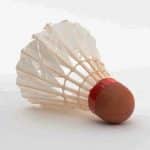




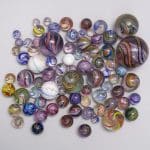



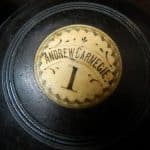

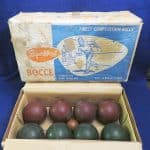
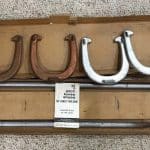

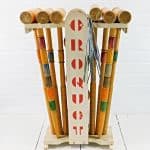




Related posts: